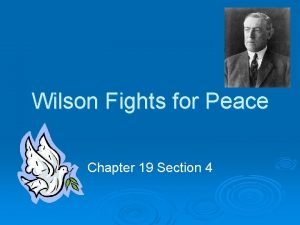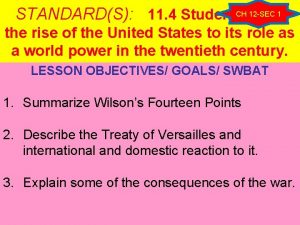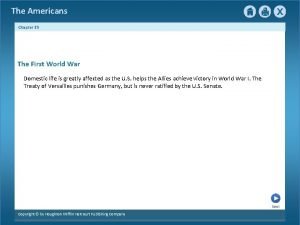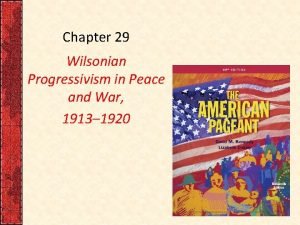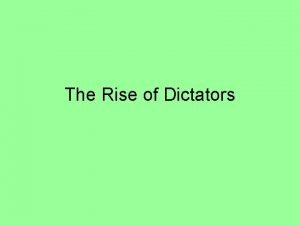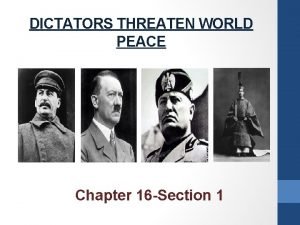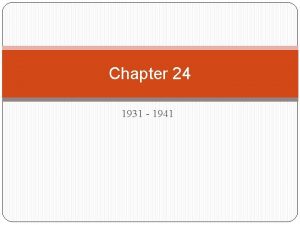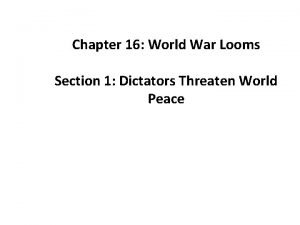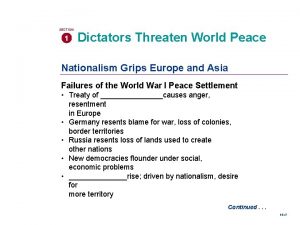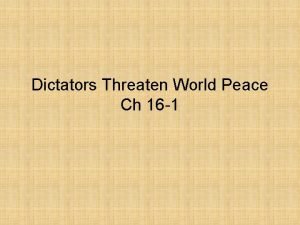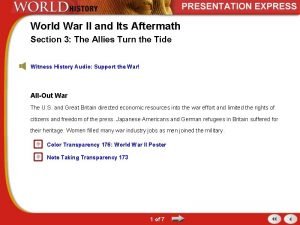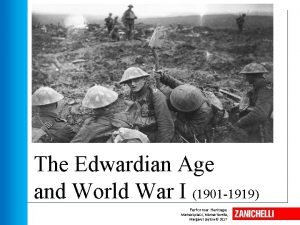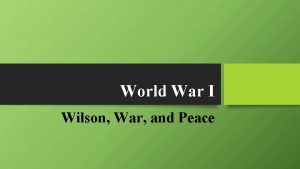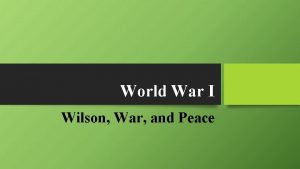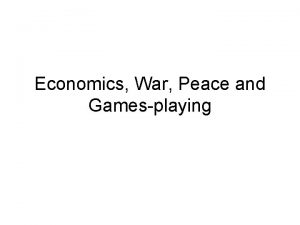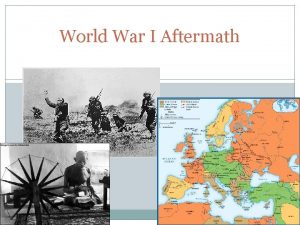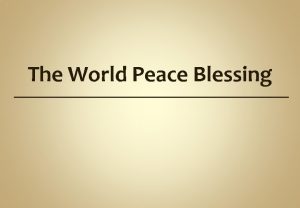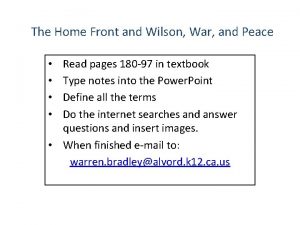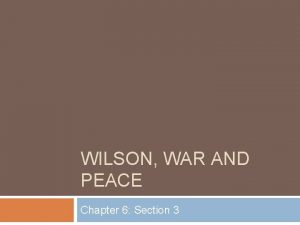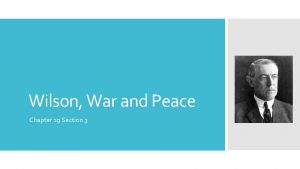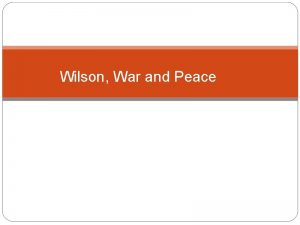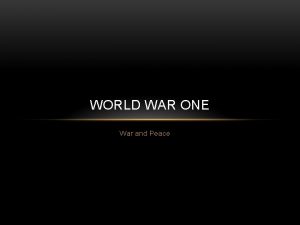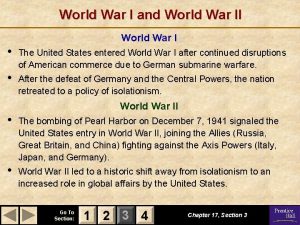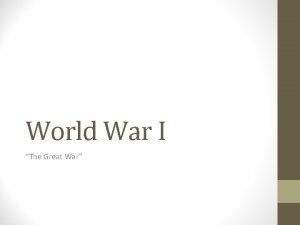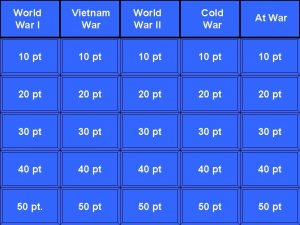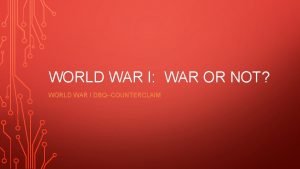WORLD WAR I OVER Wilson and the Peace

































- Slides: 33

WORLD WAR I ---- OVER! Wilson and the Peace

THE COSTS OF WAR • 10 million soldiers died in battle • No one knows exactly how many civilians died of disease, starvation, or other war related causes. • Some historians believe as many civilians died as soldiers (10 million). • 20 million wounded • Soldiers were blinded, lost limbs, suffered permanent lung damage from poison gas, or experienced psychological problems. • Much of eastern France lay in ruins (Western Front).

THE SPANISH FLU • 1918 – Flu epidemic spread. (SPANISH FLU) 20 million people die. • Epidemic: the rapid spread of a contagious disease among large numbers of people.

WILSON’S PLAN FOR PEACE • Wilson outlined his peace plan into the Fourteen Points to prevent another World War from occurring. • There were three (3) main ideas that the 14 Points represented. • The causes of the war • Territorial issues • Creation of an international peacekeeping body • What were some of his points? 1. End to Alliances 2. Freedom of the seas 3. Limit on Arms (weapons) 4. Self-determination: the right of national groups to their territory and forms of government.




WILSON’S MOST IMPORTANT POINT • 14 th Point: To create a League of Nations between nations. • Its job would be to protect the independence of all countries –LARGE or small • What cause of war (MANIA) does this point focus on? • Wilson persuaded the Allied Powers to accept his plan for peace, HOWEVER, the plan ran into trouble.

THE PEACE TREATY • Key issues were discussed by the Big Four … • Who were the BIG FOUR? 1. 2. 3. 4. Woodrow Wilson – USA David Lloyd George – Great Britain George Clemenceau – France Vittorio Orlando – Italy The Big Four met to discuss the terms of the treaty. I want to cripple Germany. Even though the war is over they are still a threat.

Was the U. S. part of the League of Nations? Why or why not?

Conflicting Goals WILSON • Wanted a “peace without victory. ” This meant that he opposed punishing the defeated countries. • He hoped to build good relations between countries in order to prevent future wars. • What do you think about Wilson’s “peace without victory”? -------------------------------------------------------------- THE OTHER ALLIES: • Wanted REVENGE • Insisted on reparations from Germany, or cash payments, to pay for all the losses from the war. • They did not want Germany to be able to build on its army again. • They wanted Germany to accept ALL responsibility for the war. • Wait!!!!!!! But what country started the war? Do you recall? ?




THE FINAL TREATY • Treaty of Versailles signed – June 1919 • Conditions of the treaty were HARSH!! • The treaty aimed at weakening Germany • Germany had to pay billions in reparations • The treaty limited the size of Germany’s military • Germany’s colonies were taken away • Germany took full blame for war ------------------------------------------------------ • The Treaty also included a few of Wilson’s ideas, such as the League of Nations.






THE BATTLE OVER THE TREATY IN THE U. S. • Most Americans favored the treaty • Isolationists: wanted the U. S. to stay out of world affairs. They opposed the treaty. • Isolationists thought the League of Nations would bring the U. S. into another war. • Henry Cabot Lodge----------U. S Senator • The debate continued, Congress did not sign the peace treaty until 1921. • The U. S. never became part of the “League of Nations”




POSTWAR TROUBLES • Labor Unrest • During the war, unions and businesses had cooperated to meet production goals. • Peacetime brought high unemployment, as soldiers came home to seek jobs. • With prices rising, unions’ demands for higher wages met stiff resistance from management. • Red Scare • Many Americans feared that Communists, or “Reds, ” were behind the labor unrest. • From 1919 into 1920 a “Red Scare, ” or fear of Communist revolution, gripped the nation.








 Wilson fights for peace
Wilson fights for peace Guided reading wilson fights for peace
Guided reading wilson fights for peace Chapter 19 section 2 american power tips the balance
Chapter 19 section 2 american power tips the balance Wilsonian progressivism in peace and war
Wilsonian progressivism in peace and war War and peace ending
War and peace ending What does jesus say about war and peace
What does jesus say about war and peace Interreligious and international federation for world peace
Interreligious and international federation for world peace Siach reciting the word over and over
Siach reciting the word over and over Handing over and taking over the watch
Handing over and taking over the watch Types of dictatorship
Types of dictatorship Chapter 16 section 1 dictators threaten world peace
Chapter 16 section 1 dictators threaten world peace World war looms chapter 24
World war looms chapter 24 Ok 313
Ok 313 Dictators threaten world peace
Dictators threaten world peace Dictators threaten world peace chapter 24 section 1 answers
Dictators threaten world peace chapter 24 section 1 answers Dictators threaten world peace
Dictators threaten world peace Chapter 16 section 1 dictators threaten world peace
Chapter 16 section 1 dictators threaten world peace Chapter 16 lesson 2 challenges to slavery
Chapter 16 lesson 2 challenges to slavery Over the mountain over the plains
Over the mountain over the plains What challenges did madison face abroad
What challenges did madison face abroad Description
Description The cold war lesson 1 the cold war begins
The cold war lesson 1 the cold war begins Korean war vietnam war venn diagram
Korean war vietnam war venn diagram Was josette dugas pro war
Was josette dugas pro war Sein remse
Sein remse Study jams force and motion
Study jams force and motion Civil war first modern war
Civil war first modern war Bringen pasado simple
Bringen pasado simple Sides of the cold war
Sides of the cold war Chapter 30 the war to end war
Chapter 30 the war to end war Chapter 30 the war to end war
Chapter 30 the war to end war World war 2 and its aftermath section 1 quiz
World war 2 and its aftermath section 1 quiz World war 1 and the russian revolution chapter 27
World war 1 and the russian revolution chapter 27 The edwardian age zanichelli
The edwardian age zanichelli
